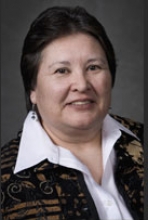Three Questions with Michelene Pesantubbee

Michelene E. Pesantubbee, the Associate Professor of Religious Studies and American Indian Native Studies, University of Iowa, will deliver the 2014 Howard Harrod Lecture, titled Native American Food Culture and the Industrial Food Complex: Bringing Back a Bison-Based Diet, on Thursday, November 6, 2014. For our readers to become acquainted with Professor Pesantubbee, we asked her to respond to three questions.
1. Name three books every student of theology/religion should read.
It is quite difficult to name just three books that every student should read. I chose three books based on my current academic interests. The books focus specifically on Native Americans but have broad applicability to other religious traditions. I am particularly interested in religious movements, in how they develop and how they are interpreted. For those two reasons I recommend Lee Irwin’s Coming Down From Above: Prophecy, Resistance, and Renewal in Native American Religions (Norman: U of Oklahoma P, 2008). This book introduces readers to the history of interpreting Native American religious movements and reassesses those approaches while offering a more culturally centered understanding of the movements. An old favorite of mine is Keith H. Basso, Wisdom Sits in Places (Albuquerque: U New Mexico P, 1996.) This study of Western Apache language and place is a beautifully written work on how Western Apache use language and place to teach and foster moral behavior as well as develop wisdom. The third book, Native Women’s History in Eastern North America before 1900 (Lincoln: U Nebraska P, 2007) edited by Rebecca Kugel & Lucy Eldersveld Murphy is a collection of essays that together provide a history of how Native American women have been studied by scholars and approaches for studying Native American women. The new commentaries added to these classic essays gives the reader insight into the processes scholars went through in their own research and writing.
2. What do you do with your free time?
What free time? When I do have free time I like to volunteer with Habitat for Humanity. Iowa City has Women’s Build projects in which only women participate in the construction of houses with some few exceptions. When I have not been able to spend time at construction sites, I’ve volunteered at Habitat Restore. Along those same lines I enjoy remodeling my own home and refinishing old furniture I often collect at the end of the academic year when everyone is tossing furniture before moving on to new adventures. Anything to keep usable stuff out of landfills.
3. In what ways are the arts (music, visual, dance, etc.) important to you and your work?
Right now dance is central to my work on Native American religious movements. Most of these movements have some form of dance renewal or creation as part of their prophecies. I am examining these movements from different dance perspectives (spatial location, movements, dress, etc.) to recreate women’s participation in the movements (since women are often given little attention in existing studies) and to interpret the movements from a more culturally centered perspective.
Click here for more information about the 2014 Howard Harrod Lecture.